If an item manages to endure time and circumstance and find its way to us, it often acquires a story along the way. A book, a letter, a document, or the like, can accumulate a compelling history independent of its original purpose and intent. Often, these stories are silent, untellable for want of any manifest record or clues. Sometimes – only sometimes – we are lucky and the story travels with the object. If fortune truly favors us, there is more than one story, these stories intertwining, encapsulated in the object. And if they are my favorite kind of stories, they tantalize us with knowns and unknowns, in equal measure.
This preamble explains why I love the object I’m writing about in this post.
On the surface, it is perhaps not so exciting. An undated, hand-written report from the First World War from a British lieutenant colonel to his superiors about night reconnaissance patrols to assess the state of German barbed wire defenses. But the officer signed the report, and his name was Winston Churchill.
Such ephemeral artifacts from Churchill’s January-May 1916 service on the Western Front, signed in his official capacity as Lieutenant Colonel in command of the 6th Royal Scots Fusiliers, are quite rare.
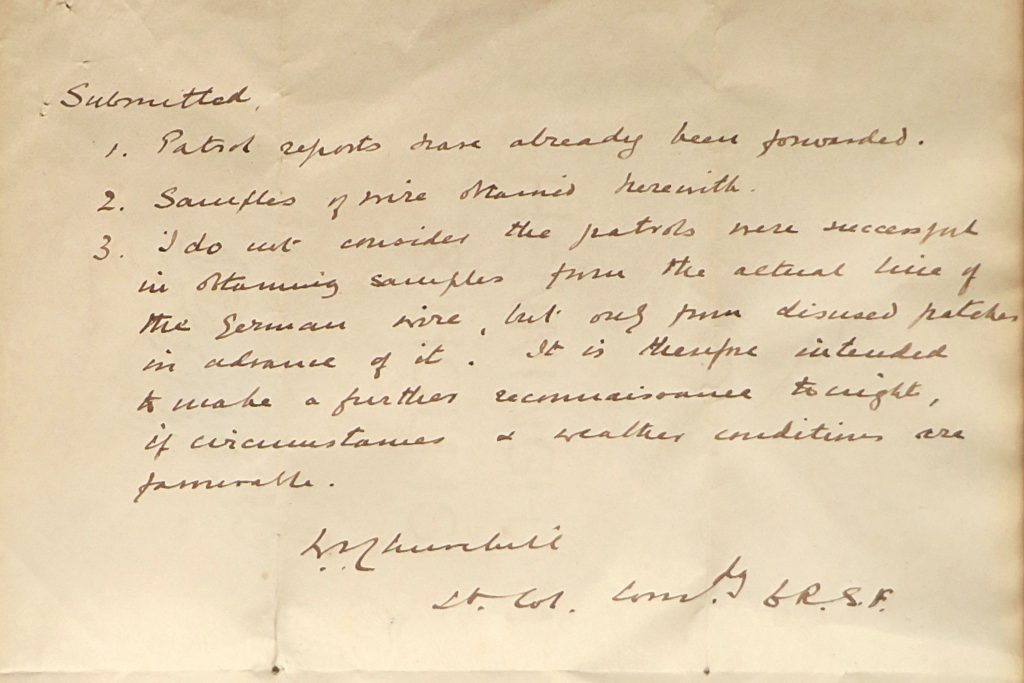
The report, inked in 12 lines on a plain sheet, reads as follows:
“Submitted,
1. Patrol reports have already been forwarded.
2. Samples of wire obtained herewith.
3. I do not consider the patrols were successful
in obtaining samples from the neutral line of
the German wire, but ones from disused patches
in advance of it. It is therefore intended
to make a further reconnaissance tonight,
if circumstances & weather conditions are
favourable.
WS Churchill
Lt. Col. Comdg. 6 R.S.F.”
The report has two vertical creases and a single horizontal crease, as if once folded small enough to fit within a pocket. The ink is a little aged, but clear, the paper a bit toned, but clean. The simple survival of such an item – perhaps the very definition of ephemera – is sufficient cause for excitement. But there is more story here. Accompanying Churchill’s 1916 field report are two 1953 pieces of correspondence that provide provenance nearly as remarkable and improbable as the survival of this artifact.
The first is a 13 August 1953 four-page autograph letter from a “J. A. Fegan” of Edinburgh, Scotland to a “Mr. and Mrs. Gray L. Foster” of Manchester, New Hampshire. The letter indicates that the Fegans met the Fosters during the latter’s tour of Scotland, after which the Fosters sent gifts to the Fegans of sugar (still rationed in post-war Britain until September 1953) and books. It seems apparent from the correspondence that the connection was warmly heartfelt, but also both unplanned and short. Fegan calls it “all-too-brief”. Fegan states “We would have been very pleased for you to visit us – we get to know one another best in our homes – but fully understand that organized tours have little room for ‘side shows’”.
The thanks for the sugar sent by the Fosters from America is direct testimony to post-war austerity in Britain. Fegan writes “that sugar rationing is likely to cease about the end of next month, so you see we are gradually climbing the hill.” This, of course, eight years after the end of the war in Europe. Fegan’s thanks “for the books” is also intriguing, particularly the lines about Fegan’s reading “again Lincoln’s Second Inaugural and particularly the final paragraph, which is so appropriate at the present time ‘With malice towards none…” – testimony to the nascent Cold War which, once again, saw the U.S. and Britain aligned and allied. Of note, Churchill had a keen interest in the Civil War, toured Civil War battlegrounds with Eisenhower, admired Lincoln, and even invoked Gettysburg – twice – when addressing the U.S. Congress, both in December 1941 and again in May 1943
But page three of Fegan’s letter is what can cause a sharp intake of breath. There Fegan wrote:
“I would like you to accept one of my war souvenirs, which I feel will interest you. During the first six months of 1916, Winston Churchill commanded a Battalion – the 6th Royal Scots Fusiliers – in the Division which I served. The Division for part of that time was holding a quiet sector of the line at Ploegsteert, after being badly mauled at Ypres, but local raids were made on the enemy lines from time to time. The enclosed report refers to a night reconnaissance made by patrols to find out the strength of the wire preparatory to making one of these raids, and I got the report from Brigade Head-quarters later. It is undated, but it was about the middle of May 1916.”
There it is. Not only provenance, but an explanation of why and how this particular report survived its fleeting momentary relevance amidst the veritable blizzard of such documents that undoubtedly crowded “Brigade Head-quarters”.
The second letter in the envelope is a typed copy of Mr. Foster’s 3 September 1953 response, thanking Fegan for his gift. Churchill would doubtless have appreciated Foster’s extravagant praise (“the greatest man living in my term of years”), but it is the last sentence of Foster’s first paragraph that might have made Churchill smile in quiet satisfaction. Churchill did much to cultivate, cement, and sustain an alliance among the world’s English-Speaking peoples, and actually coined the phrase “Special Relationship” to enshrine the Anglo-American bond. Of the gift of Churchill’s report, Foster tells Fegan “I have told my two daughters about you and your family, and it was their suggestion that we permanently keep your letter as proof that individuals can develop international relations on a high plane.” Foster’s letter closes “…I hope that in time to come you will be prompted to drop us another line. Certainly, a new friendship like this should not be allowed to lapse.”
Of the gift of Churchill’s report, Foster wrote to Fegan “…it touched me very deeply because I know how much this particular war souvenir meant to you. Mrs. Foster and I both felt that you are doing much more for us than you should in parting with this valuable memento. However, we want you to know that this is highly cherished and it is going into our safety deposit box. Also going into my safety deposit box is your letter of August 13th.”
Apparently, ten years in the safety deposit box proved long enough. The report is framed in gilt wood with what appears to be a jute mat. We have not removed the item from the frame owing to what we found on the back. Affixed to the top center of the frame’s backing is the illustrated sticker of “The Old Print and Frame Shop, Inc” of “Boston 8, Massachusetts”. Hand-written on the sticker is a date of “63”. When the item was framed, a large envelope was affixed to the lower half of frame’s backing, in which the two 1953 pieces of correspondence from Fegan and Foster are preserved.
As you might imagine, we were keen to know the identity of both Fegan and Foster.
Thanks to The Royal High School of Edinburgh Roll of Honour 1914-1918 (Oliver and Boyd, Tweeddale Court, Edinburgh 1920) and the National Library of Scotland, we know that John Adam Fegan, born 1886, served nearly the entire length of the First World War. His service history: Private, 12th Royal Scots, August 1914; Sergeant, October 1914; Company Quartermaster-Sergeant, January 1916; 2nd Lieutenant, April 1918. Awarded Military Medal, April 1917. Mentioned in Despatches, June 1917 and January 1919. Wounded at Ledeghem, October 1918. Fegan would have been in his late sixties when he met and befriended the Fosters and gifted them this artifact from Churchill’s First World War active service. Remarkably, Churchill was still serving, albeit in a different capacity; at 78, he was in the midst of his second and final premiership, leading his entire nation during a difficult peace rather than a battalion during a bloody war.
It is a small but poignant reminder of the sheer scope of the First World War’s carnage that The Royal High School of Edinburgh Roll of Honour 1914-1918, which recorded John Adam Fegan’s service history, contains 929 names of those who served, of whom 174 fell. All attended just one high school in Scotland.
But back to our story. In fact, we have multiple stories. The story of the item itself, of course. The story of how it came to be preserved. And the story of how it came to pass, by way of reciprocal gifts, across the Atlantic, from British hands to American.
Equally intriguing is what we don’t know. None of the stories is complete.
We don’t know any more about John Adam Fegan other than his date of birth, service record, 1953 address, and apparent long residence in Edinburgh.
We don’t know anything about “Gray L. Foster” other than his Manchester, New Hampshire address. There is an intriguing clue in Fegan’s letter; when writing about the books received, Fegan said “Those issued by your company provide excellent thumb-nail sketches which I shall enjoy reading with ‘The American Canon’ in my hands.” In theory, “issued by your company” is an important clue, but not one that we have yet been able to exploit. We also don’t know whether the Fegans and the Fosters remained in touch. Or why, after ten years, Churchill’s report was framed and preserved in the company of these two letters.
Equally intriguing, we don’t know on what date Churchill composed and submitted this report, whether there was a follow-on report, or what, if any, action was taken as a result. In his 13 August 1953 letter, Fegan states of Churchill’s report “It is undated, but it was about the middle of May 1916.” Whether we attribute the error to the erosion of date-specific memory after more than four decades, or the fact that Fegan “got the report from Brigade Head-quarters later”, the “middle of May 1916” date is likely not *quite* accurate. The report was written sometime between 1 January and the first week of May, 1916.
This certainty results from history we all know. A quarter of a century before he served as British Prime Minister during the Second World War, Winston Churchill played a critical, controversial, and varied role in “The war to end all wars”. In October 1911, aged 36, Winston Churchill was appointed First Lord of the Admiralty with the brief to change war strategy and ensure the readiness of the world’s most powerful navy. He did both before the outbreak of the First World War in 1914. Nonetheless, when Churchill advocated successfully for a naval campaign in the Dardanelles that ultimately proved disastrous, a convergence of factors sealed his political fate. Churchill was scapegoated and forced to resign, leaving the Admiralty in May 1915. By November 1915, Churchill had resolved to join the troops on the Western Front.
After training, On New Year’s Day 1916 he learned he would be appointed to command the 6th Battalion of the Royal Scots Fusiliers. The next day he received his commission as a temporary lieutenant-colonel, the highest rank he would reach in the army. Churchill spent nearly six months in the field, more than four of these months at Ploegsteert, Belgium, part of the Ypres Salient. Churchill briefly returned to London only from 7 to 13 March to attend Parliament, having remained MP for Dundee while in the field. Upon the news that his Battalion was to be dissolved, Churchill decided not to seek a new appointment and, on 7 May 1916 he returned permanently to Parliament.
Churchill’s political career would ultimately last two thirds of a century, see him occupy Cabinet office during each of the first six decades of the twentieth century, and carry him twice to the premiership. Documents and correspondence signed in his various official civilian leadership capacities are certainly collectible, many even precious, but not unusual given the eleven different Cabinet offices he held (three of them more than once). By contrast, official communications from this period of Churchill’s active military service are quite uncommon.
We welcome the opportunity to share this item with you and invite you to help us finish sussing and sharing its story.
This item is offered for sale HERE on our website.
Cheers!

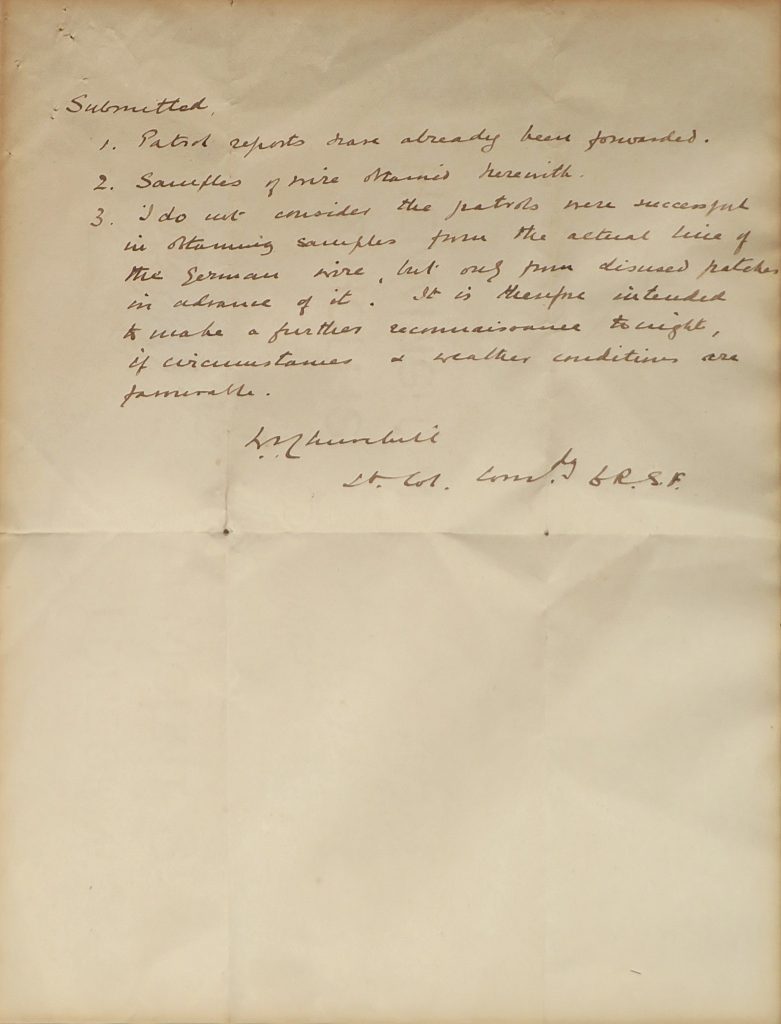
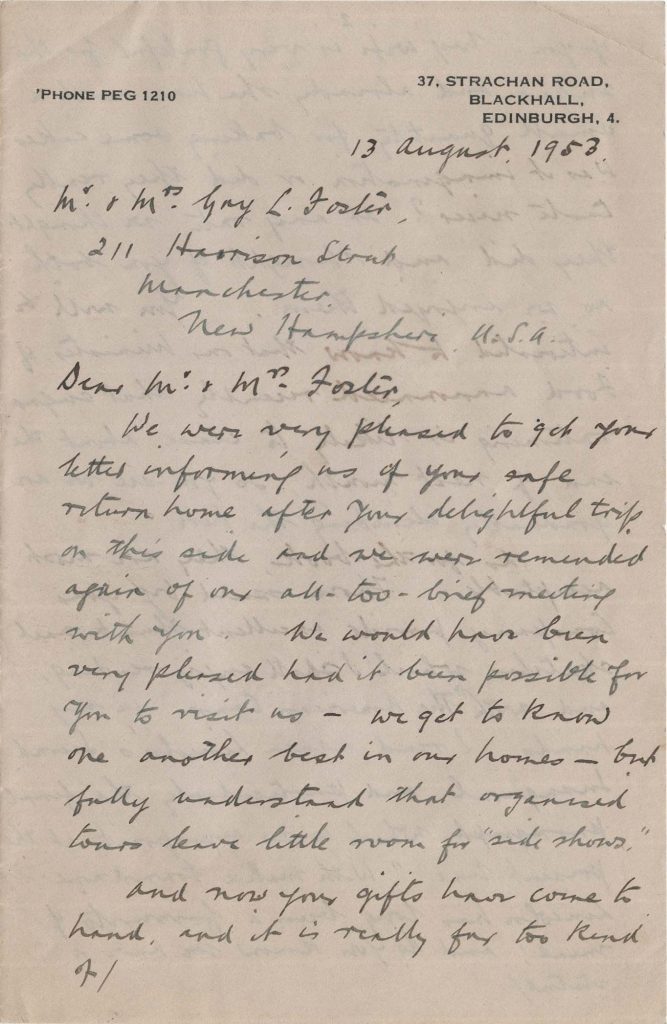
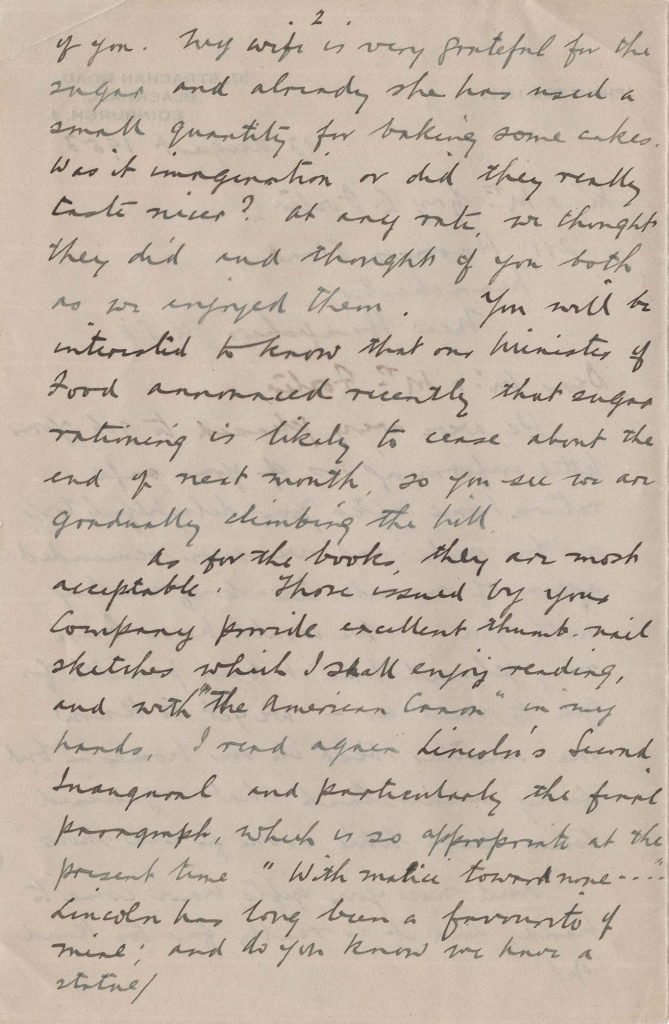
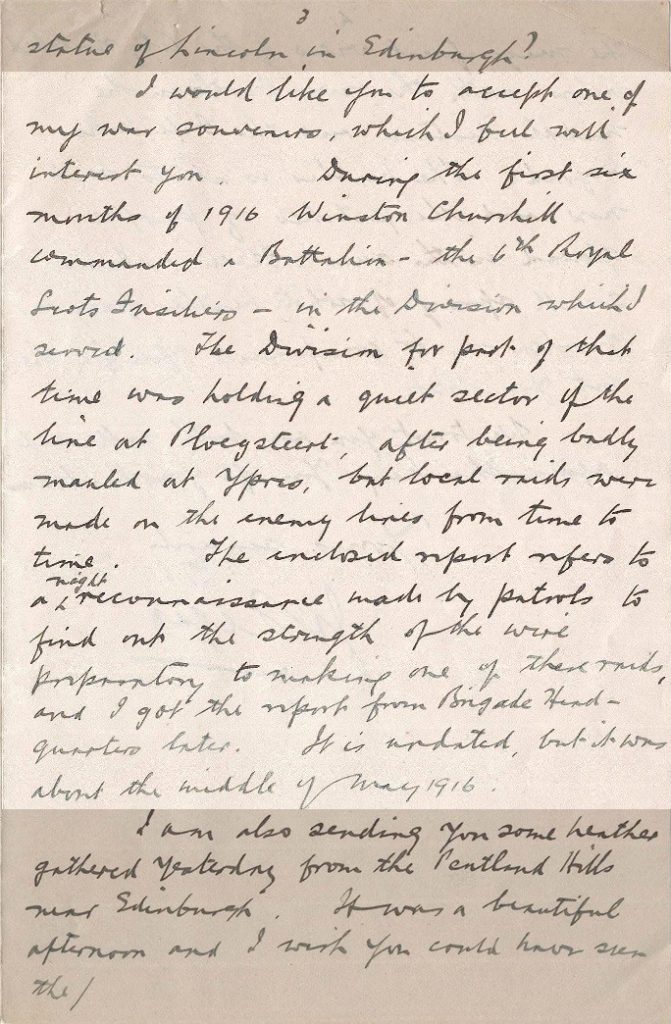
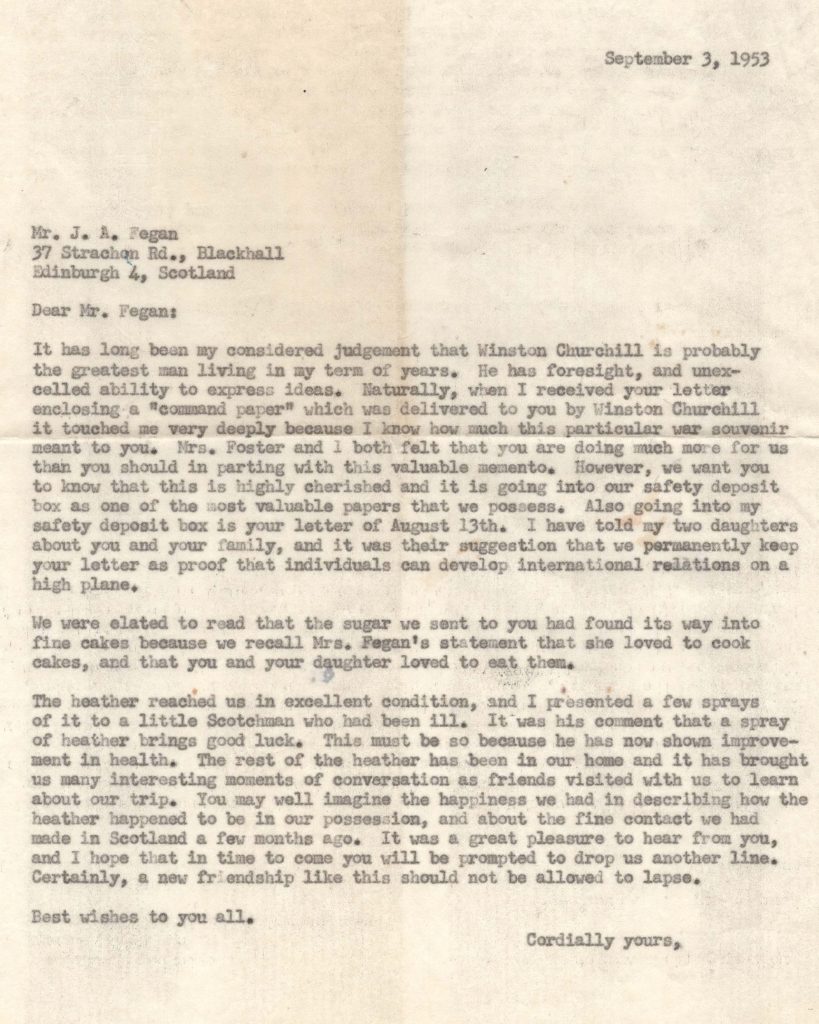
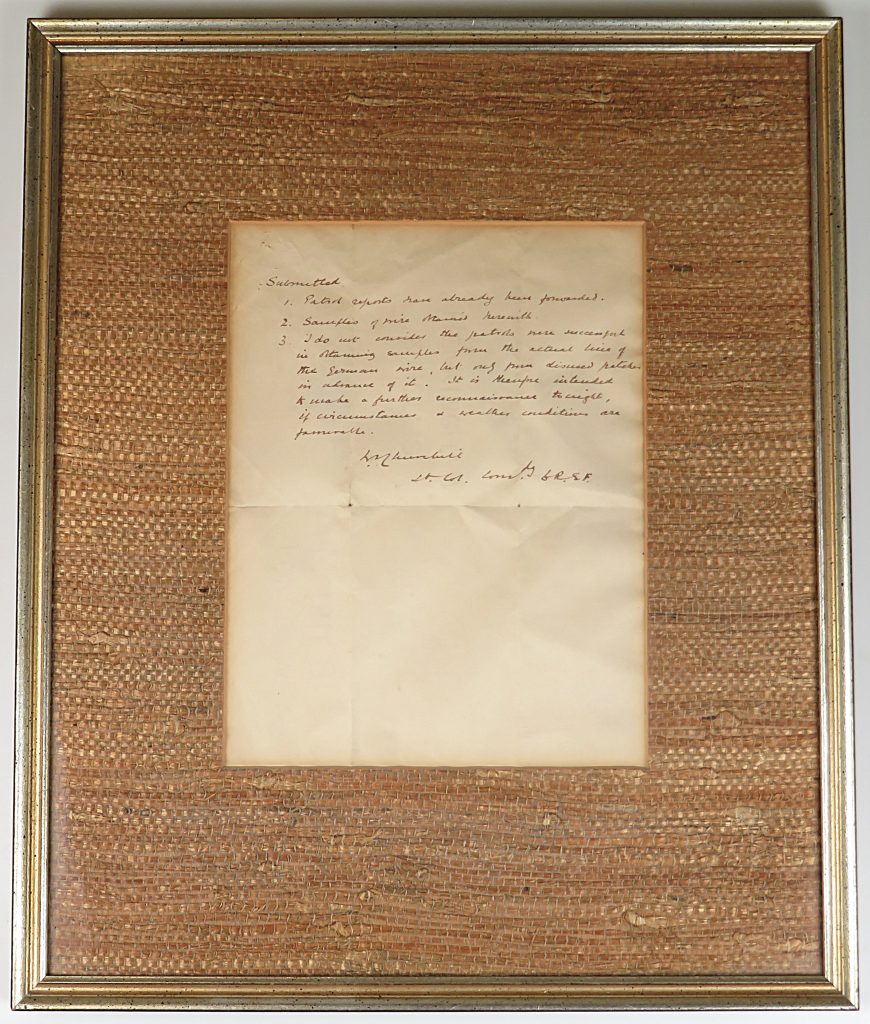
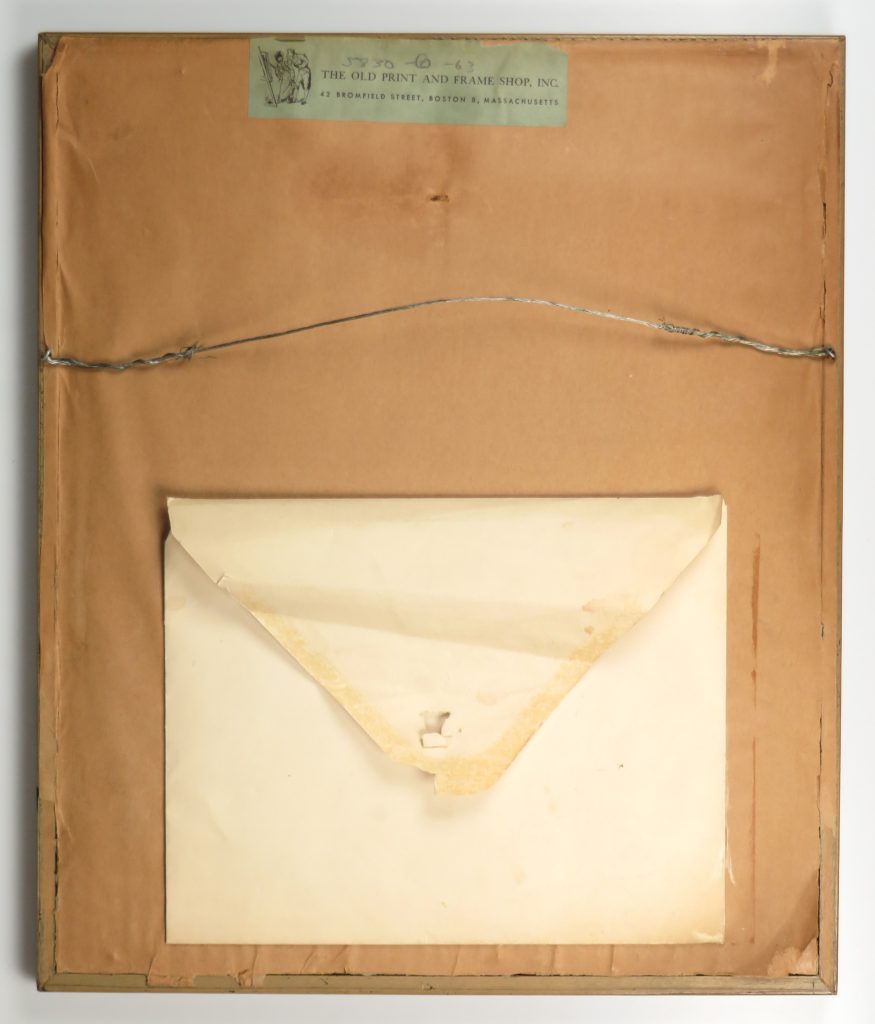
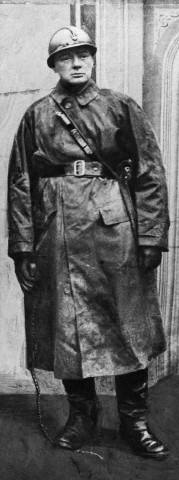
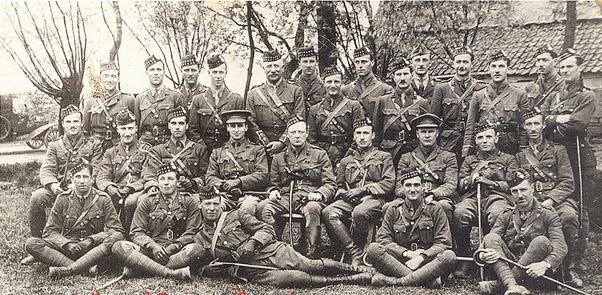
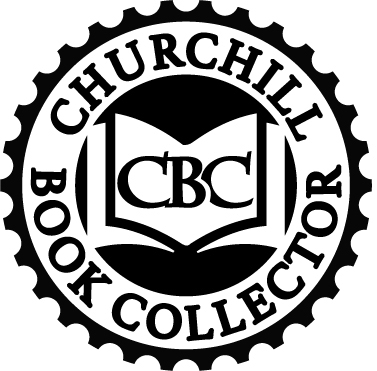
2 thoughts on ““… a further reconnaissance tonight, if circumstances and weather conditions are favourable.””